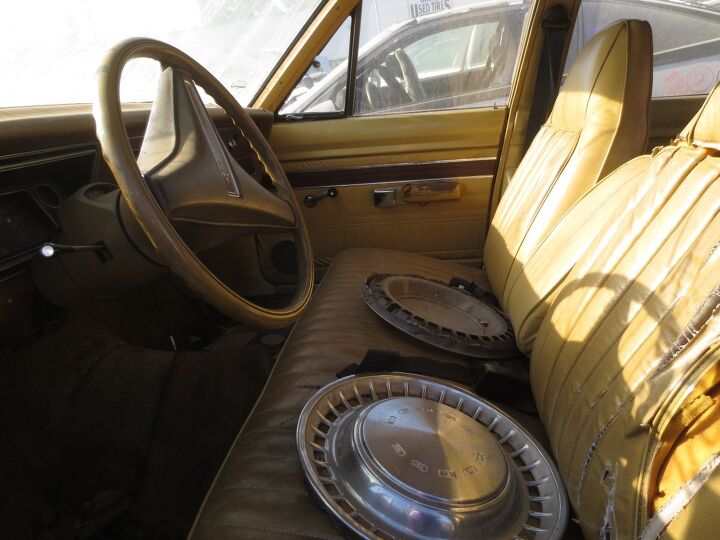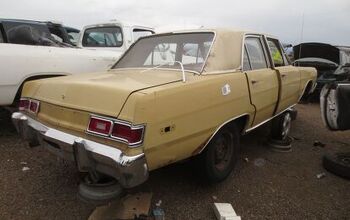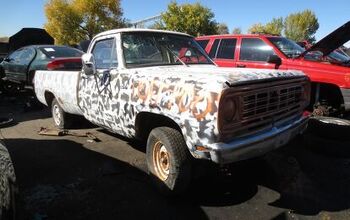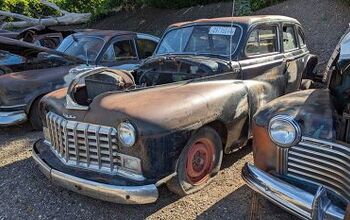Junkyard Find: 1975 Dodge Dart Sedan

So many Chrysler A-bodies in junkyards these days, even though the last ones rolled off the assembly line in 1981 (in South America and Australia; the final Detroit-built A-body was a 1976 model). These cars were cheap and simple, and they’re still useful transportation in the 21st century, so many of them manage to stay on the street well into their 30s and 40s. Sadly, even the most fanatical Dart/Valiant restorer has all the affordable two-doors and/or factory V8 cars he or she can handle, and so when a made-by-the-zillions Slant-6 Malaise Era sedan craps out, it’s going to The Crusher. So far in this series, we’ve seen this ’60 Valiant wagon, this ’61 Valiant, this ’63 Dart, this ’64 Valiant wagon, this ’67 Valiant, this ’66 Dart, this ’68 Valiant Signet, this ’73 Valiant, this ’75 Duster, and this ’75 Dart, and now we’re adding yet another ’75 to the list.
This is a California car, so there’s absolutely zero rust and the upholstery is pretty well roasted by the sun.
Did it finally die?
When I shot this car, it had only been on the yard for a few days. You can tell because the front brake parts, which are highly sought-after because they’ll bolt right on to B-body cars such as Chargers and Belvederes, were still there. By now, of course, the car has been shredded, dumped into a shipping container at the Port of Oakland, shipped to China, and melted down; I photographed it last October, in a yard that keeps inventory for a mere two months before scrapping it.
According to my favorite junkyard-inventory site, there are two Darts, six Valiants, a Duster, and two Swingers in the inventory of the 90 yards Row52 tracks, which means there are many hundreds of fresh A-bodies in the junkyards they don’t cover. If you’ve ever wanted one, now is the time!

Murilee Martin is the pen name of Phil Greden, a writer who has lived in Minnesota, California, Georgia and (now) Colorado. He has toiled at copywriting, technical writing, junkmail writing, fiction writing and now automotive writing. He has owned many terrible vehicles and some good ones. He spends a great deal of time in self-service junkyards. These days, he writes for publications including Autoweek, Autoblog, Hagerty, The Truth About Cars and Capital One.
More by Murilee Martin
Latest Car Reviews
Read moreLatest Product Reviews
Read moreRecent Comments
- SCE to AUX All that lift makes for an easy rollover of your $70k truck.
- SCE to AUX My son cross-shopped the RAV4 and Model Y, then bought the Y. To their surprise, they hated the RAV4.
- SCE to AUX I'm already driving the cheap EV (19 Ioniq EV).$30k MSRP in late 2018, $23k after subsidy at lease (no tax hassle)$549/year insurance$40 in electricity to drive 1000 miles/month66k miles, no range lossAffordable 16" tiresVirtually no maintenance expensesHyundai (for example) has dramatically cut prices on their EVs, so you can get a 361-mile Ioniq 6 in the high 30s right now.But ask me if I'd go to the Subaru brand if one was affordable, and the answer is no.
- David Murilee Martin, These Toyota Vans were absolute garbage. As the labor even basic service cost 400% as much as servicing a VW Vanagon or American minivan. A skilled Toyota tech would take about 2.5 hours just to change the air cleaner. Also they also broke often, as they overheated and warped the engine and boiled the automatic transmission...
- Marcr My wife and I mostly work from home (or use public transit), the kid is grown, and we no longer do road trips of more than 150 miles or so. Our one car mostly gets used for local errands and the occasional airport pickup. The first non-Tesla, non-Mini, non-Fiat, non-Kia/Hyundai, non-GM (I do have my biases) small fun-to-drive hatchback EV with 200+ mile range, instrument display behind the wheel where it belongs and actual knobs for oft-used functions for under $35K will get our money. What we really want is a proper 21st century equivalent of the original Honda Civic. The Volvo EX30 is close and may end up being the compromise choice.












































Comments
Join the conversation
The "Little Old Lady from Pasadena" was real. No, not the hod-rod granny from the Jan and Dean song. She was the legend conjured up by a million fast-talking used-car salesmen from the '50s and '60s while trying to move their used, abused, rolled-back odometer junkers quickly spiffed up and presented on a lot with multi-colored flags on a string waving in the breeze overhead; beckoning the unwary and lower of income. But Loretta's car never saw such a lot. No, the copper-colored Dodge sedan was the last car bought new by her frugal late husband. The Dodge Dart was made for such men as Harold (never Harry). It's unremarkable, frill-free stalwartness appealed to him. The Slant Six already had a reputation for being indestructible; likewise the Torqueflite 904 transmission. Harold liked that. He believed that the kind of car a man drove reflected his personality. Harold was equally stalwart and unremarkable. Grew up on an orange grove, served in World War II, then was employed in a factory for the next thirty years. There was really nothing more you could say about him; other than he was a good man who provided well for his family, sent his son and daughter to college and was proud of how they turned out, then he passed away during the Reagan years; quietly satisfied that the world turned out just how he hoped it would when he voted for him. His wife Loretta continued to drive the Dodge. Her kids said, "Mom, why don't you buy a new car?" They didn't get it. They spent freely; a new car every couple of years, usually German and priced twice what a car should be. A giant house in the far suburbs, cheap looking and priced dearly; not like the solid Craftsman house on a tree-lined street closer to town that they grew up in. Why, the drive to work takes them nearly an hour in each direction! Loretta shook her head, but never mentioned her concerns; after all by all appearances they were doing well. Loretta drove the Dodge. Why not? It was paid for, and still ran like a watch thanks to Uncle Al, the family mechanic who owned a little shop that served a dwindling number of regular customers. The oil changes were inked onto a little strip of paper with the Pennzoil logo on top, stuck to the door jamb. Al made sure the oil and filters were changed, valves adjusted, suspension greased, new brake pads installed on freshly-turned rotors, and the carburetor and timing were dialed in just so-which was getting harder and harder to do on cars every year; then he returned the car freshly washed and vacuumed inside. Loretta drove the Dodge, after Chrysler nearly went bankrupt, when a Dodge was a punchline on a long-running sitcom, when they stopped making Plymouths; even when she finally sold the Craftsman house-for nearly a million dollars!-and moved into a retirement community. It never went faster than 40 miles per hour on the streets of Pasadena; and it went even slower on Southern California's perpetually jammed freeways. Loretta drove the Dodge until she passed away peacefully in her sleep. Her kids thought of offering it to one of their college-age children but none of them drove or even had a license. They thought of putting it on Craigslist but were wary of the hassle, or donating it to charity; but in the end the Dodge took it's final journey to the Pick and Pull behind a tow truck. Her kids couldn't find the keys.
Darts were pretty popular in Finland back in the day. They were sold as executive cars, and without emissions equipment tended to be fairly quick - there were no emissions testing or ratings at that time, and apparently export cars had very little if any emissions gear installed in the first place. Darts and Valiants were also pretty well made, as there are hundreds of them still on the roads. Most of the best selling cars of the era, and even many 1980s models, have disappeared almost completely.